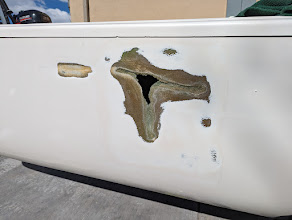Fiberglass to Gel Coat on my Hobie 21
I recently had a rather big repair on my Hobie21 Sport Curser. I drove 2000 miles to buy and pick up this rare boat and a few min after paying 8 grand cash for it I put a big hole in the side while pulling into a tight parking lot to grab some Chinese food, a garbage can jumped out, and hit my boat. I noticed the impact on the boat after we filled up on Chow Main and General Tsos Chicken.
I was jonesing to take for a ride on on Tampa Bay before I made the 2000-mile drive back Home to Utah so I dropped by AutoZone and picked enough fiberglass and polyester resin to apply a makeshift patch. Even though this was a temporary patch, I still gave the spot a good sanding and cleaning to make sure the 6 layers of fiber adhered.
There is a lot of stress from the force of twist on the hulls of a catamaran and this temp patch not only looks terrible but likely introduced a weak spot in the hull. So when I got the boat back to Utah I had to grind off the patch with a sanding disk attached to an angle grinder. I also cut an opening in the deck and installed a deck plate so I could prepare the inside for repair.
You can see that I made an attempt to feather out the damaged spot from both the inside and outside. Hobie Cats are made by sandwiching foam between inside and outside layers of fiberglass. After Preparing and patching the inside I filled the gap of what was once foam with structural fiberglass fill. and then cut several layers of polyester fabric in the shape of the void, each layer bigger than the previous. I used this technique for both inside and outside patches with structural fill in between.
After sanding and prepping the area again, I laid down a layer of polyester fairing compound.
After sanding faring and cleaning I ended up with a pretty strong repair and a fairly smooth surface.
The final step is the gel coat. The previous owner had given me 8 oz of matching non-wax gel coat which I laid down in several layers, allowing each layer to dry for about an hour before applying the next layer and alternating brush on the pattern. I also applied a coat of PLA (Polyester Vinyl Alcohol) which allows the Gel Coat to set up properly.
The green tint came from the PVA. After 24 hours of curing the green washed off and I was ready to sand. I started with 120 grits to knock down the brush strokes, then moved on to 240, 500, 1500, and 2000 grits and finished off with buffing and polishing using a wool buffer and polishing compound.
If I were really going to get picky I would do one more layer of gel coat, my finishing skill here was far from perfect, but perfection is the enemy of progress and the scar adds just enough character to the boat to justify her new name. We call her #Patch
I used Total Boat Products for the whole job except for the gel coat and it turned out great.
I also recommend checking out Boat Works Today on YouTube:










Comments
Post a Comment